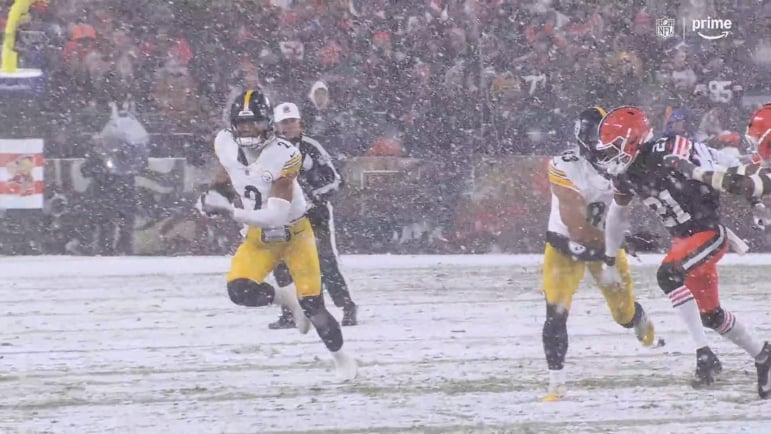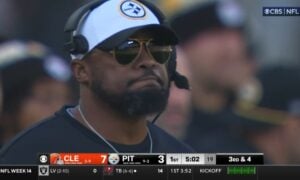For Kermit The Frog, it ain’t easy being green. And for the Pittsburgh Steelers and the fanbase, the idea of “play Justin Fields” is more complicated than that. His talent is worth exploring, but he isn’t the Flextape seal of “he’ll fix everything,” red zone or otherwise.
It turns out there’s a reason teams prefer to have just one quarterback. Rotating in someone else brings a lot of layers. Pittsburgh found that out the hard way in Thursday night’s loss to the Cleveland Browns.
Here are just a handful of things to consider.
How do we quickly get play calls in? How do other players know he’s coming in?
Linking these two questions together. Against Baltimore and Cleveland, Pittsburgh had major problems breaking the huddle on key fourth downs. Getting to the line with under 10 seconds left only rushes everything. There’s the risk of OC Arthur Smith delaying while he decides whether or not to use Fields, having to process the down/distance in real-time to determine if it’s the right moment to use Fields or not.
Bringing in Fields often means a wholesale shift in personnel, too, which can create delays. Then, everyone else has to be on the same page and know it’s happening. On a fourth down against Cleveland, C Zach Frazier saw QB Russell Wilson jog off the field after a third down and assumed the Steelers were punting. He walked off, too, as OG Isaac Seumalo followed his lead. But Wilson only came off so Fields could come on, meaning the linemen had to rush back on.
These personnel changes, especially on the road, create stress. And there’s enough of that in those weighty moments, third and fourth down, for an offense with young pieces outside of Wilson.
How do we balance run and pass with him? How do we have enough plays?
Call it the Dri Archer problem—the red flashing light that appears when Fields comes on the field. Now, Fields is obviously more talented and versatile than Archer, but there’s a heavy run tendency when Fields is out there. Teams respond by packing the line of scrimmage.
It makes things ripe to throw, but as it was played out against Cleveland, do you go for broke on 3rd and 4? The Browns had no deep safety and sold out against the run. That is why Fields put it up deep for George Pickens. The payoff is huge. Complete the pass, and you will essentially win the game. Miss it and the Browns get another good shot to win – which they did. And do you try to surprise by having Fields throw deep instead of Wilson, even though Wilson is the better deep ball passer?
How do you make the Fields package versatile enough that it doesn’t become predictable while still serving him and the offense of not being so varied that it’s hard to practice reps and have a good, tight plan?
How does he stay loose?
A hidden issue. You have Fields in the cold coming on the field to run. Even on plays that worked, there’s a drawback. Fields believed he would’ve scored on his 30-yard zone read, a nice play call with an arc block by TE Connor Heyward, had he felt looser. But his body was tight from being frozen on the sidelines, and he couldn’t open up and run like usual.
The Steelers are playing outdoors and in the cold the rest of the way. There are three more home games with road contests in Cincinnati, Baltimore, and Philadelphia. Plus playoffs. This obstacle isn’t going away.
How do we distribute reps?
In practice and in-game. How much time do you dedicate to using the Fields package in practice when you’re unsure how many in-game chances you’ll get? And how many plays do you work on? The more you do, the more versatile the package becomes, but the more time you spend.
The good news is that some of the base runs, like QB power, have already been used throughout the season when Fields was starting. Less time is needed to rep them now. Still, you’re trying to feed your plays for Wilson and squeeze in time for Fields.
It’s even tougher on short weeks. Pittsburgh has two more coming up: Weeks 15-16, which go from Sunday to Saturday, and Weeks 16-17, which go from Saturday to Wednesday. Should the team be playing on the Saturday of Wild Card weekend, it could potentially be a short week for the postseason.
In-game, you balance game flow and rhythm, though I find that to be less of an issue than others.
Final Thoughts
All of these things are solvable. And it’s the coaching staff’s job to solve them. But they’re all factors that get considered in the equation and issues that must be worked out on top of everything else the team is doing in the middle of the season. Fields should play. I’ve advocated for that the entire season. He’s too talented to leave on the bench as a true No. 2. But there are layers and nuances to how you use him, how it impacts the team, and how to keep things fluid and on schedule to win.








